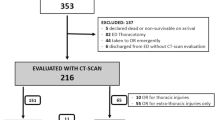Abstract
Introduction
Penetrating cardiac injuries are infrequent but highly lethal. To address these injuries, cardiopulmonary bypass and cardiothoracic surgery availability are required for Level I trauma center verification. However, acute care surgeons are more readily available for this time-sensitive injury. The purpose of this study was to review an acute care surgery-based experience with penetrating cardiac trauma at an urban Level 1 trauma center. Our hypothesis was that care provided solely by acute care surgeons was both safe and effective for this patient population.
Methods
All patients with injuries to the ‘cardiac box’ following penetrating thoracic trauma were identified from 2005–2010. Demographic and injury related data were obtained. The types and location of cardiac injury, as well as patient outcomes, were determined from operative reports.
Results
1701 patients with penetrating chest trauma were admitted during the study period. 260 patients were identified as having high-risk injuries and were included in the review. 37 patients underwent resuscitative thoracotomy, with a survival rate of 8 %. 76 patients (29 %) suffered a cardiac injury. 72 % of these patients had a preoperative FAST exam, which had a sensitivity and specificity of 56.5 and 82.5 % respectively. 82 % underwent a pericardial window, which had a positive predictive value of 81.4 %. 61 % (n = 46) of the patients with a cardiac injury survived, while the overall death rate in this cohort was 21 %. No patients in the cohort required cardiopulmonary bypass for emergent repair of cardiac injury and acute care surgeons performed all cases.
Conclusion
Penetrating injury to the heart is highly lethal and time-sensitive. Increasingly, FAST and subxyphoid pericardial window are relied upon to make the diagnosis in patients arriving in varying stages of shock to the resuscitation room. Acute care surgeons are the most appropriate surgeons to care for these injuries and provide safe and effective care.

Similar content being viewed by others
References
Nicol AJ, Navsaria PH, Beningfield S, et al. Screening for occult penetrating cardiac injuries. Ann Surg. 2015;261(3):573–8.
Rupprecht H, Ghidau M. Penetrating nail-gun injury of the heart managed by adenosine-induced asystole in the absence of a heart-lung machine. Tex Heart Inst J. 2014;41(4):429–32.
Chughtai TS, Gilardino MS, Fleiszer DM, et al. An expanding role for cardiopulmonary bypass in trauma. Can J Surg. 2002;45(2):95–103.
Kaljusto ML, Skaga NO, Pillgram-Larsen J, et al. Survival predictor for penetrating cardiac injury; a 10-year consecutive cohort from a Scandinavian trauma center. Scandinavian J Trauma Resusc Emerg Med. 2015;23:41.
Asensio JA, Berne JD, Demetriades D, et al. One hundred five penetrating cardiac injuries: a 2-year prospective evaluation. J Trauma. 1998;44(6):1073–82.
Pereira BMT, Nogueira VB, Calderan TRA, et al. Penetrating cardiac trauma: a 20-year experience from a university teaching hospital. J Surg Res. 2013;183(2):E1–6.
American College of Surgeons Committee on Trauma. ACS Orange Book. Chicago, IL: American College of Surgeons; 2014.
Beck CS. Two cardiac compression trials. JAMA. 1935;104:714–6.
Baker L, Almadani A, Ball CG. False negative pericardial focused assessment with sonography for trauma examination following cardiac rupture from blunt thoracic trauma: a case report. J Med Case Rep. 2015;9:155.
Kong VY, Oosthuizen G, Sartorius B, et al. Penetrating cardiac injuries and the evolving management algorithm in the current era. J Surg Res. 2015;193:926–32.
Thorson CM, Namias N, Van Haren RM, et al. Does hemopericardium after chest trauma mandate sternotomy. J Trauma Acute Care Surg. 2012;72(6):1518–25.
Thourani VH, Feliciano DV, Cooper WA, et al. Penetrating cardiac trauma at an urban trauma center: a 22-year perspective. Am Surg. 1999;65:811–8.
Van Waes OJ, Van Riet PA, Van Lieshout EM, et al. Immediate thoracotomy for penetrating injuries: ten years’ experience at a Dutch level I trauma center. Eur J Trauma Emerg Surg. 2012;38(5):543–51.
Rabinovici R. Sixty-seven consecutive resuscitative thoracotomies by a single surgeon. Scand J Surg. 2014;103(2):156–60.
Rhee PM, Acosta J, Bridgeman A, et al. Survival after emergency department thoracotomy: review of published data from the past 25 years. J Am Coll Surg. 2000;190(3):288–98.
Rozycki G, Ochsner M, Schmidt J, et al. A prospective study of surgeon-performed ultrasound as the primary adjuvant modality for injured patient assessment. J Trauma. 1995;39:492–8.
Rozycki GS, Feliciano DV, Ochsner MG, et al. The role of ultrasound in patients with possible penetrating cardiac wounds: a prospective multicenter study. J Trauma. 1999;46:543–51.
Plurad DS, Bricker S, Van Natta TL, et al. Penetrating cardiac injury and the significance of chest computed tomography findings. Emerg Radiol. 2013;20:279–84.
Arom KV, Richardson JD, Webb G, et al. Subxyphoid pericardial window in patients with suspected traumatic pericardial tamponade. Ann Thorac Surg. 1977;23:545Y549.
Trinkle JK, Toon RS, Franz JL, et al. Affairs of the wounded heart: penetrating cardiac wounds. J Trauma. 1979;19:467Y472.
Hommes M, Nicol AJ, van der Stok J, et al. Subxyphoid pericardial window to exclude occult cardiac injury after thoracoabdominal trauma. Br J Surg. 2013;100:1454–8.
Onan B, Demirhan R, Oz K, et al. Cardiac and great vessel injuries after chest trauma: our 10 year experience. Turk J Trauma Emerg Surg. 2011;17(5):423–9.
Author information
Authors and Affiliations
Corresponding author
Ethics declarations
Conflict of interest
Ethan W. Stranch, Ben L. Zarzaur and Stephanie A. Savage have no conflicts of interest to declare.
Rights and permissions
About this article
Cite this article
Stranch, E.W., Zarzaur, B.L. & Savage, S.A. Thinking outside the box: re-evaluating the approach to penetrating cardiac injuries. Eur J Trauma Emerg Surg 43, 617–622 (2017). https://doi.org/10.1007/s00068-016-0680-7
Received:
Accepted:
Published:
Issue Date:
DOI: https://doi.org/10.1007/s00068-016-0680-7




